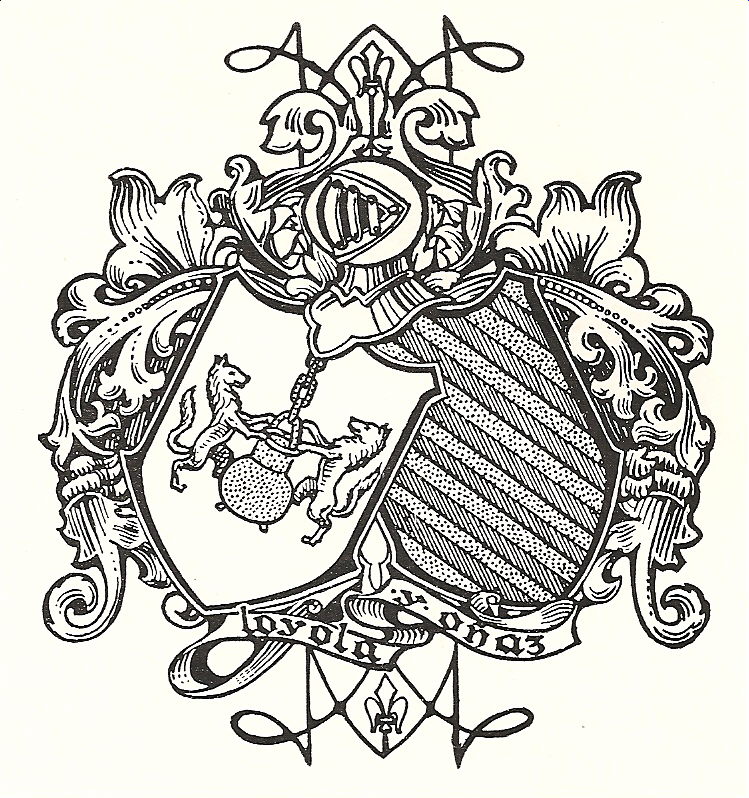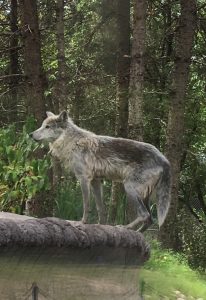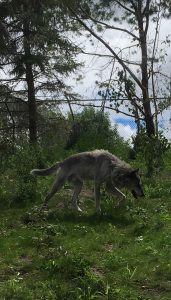“Someone told me it’s all happening at the Zoo. I do believe it. I do believe it’s true.”

“A howling new exhibit at the Assiniboine Park Zoo is set to open this weekend.
The Zoo announced Thursday that the zoo’s grey wolves will make their home in a brand new habitat just in time for Father’s Day…. APZ’s wolf pack, which includes four males and one female, first arrived to the Zoo in 2014 and has since made their home in the award-winning Journey to Churchill exhibit.”
WINNIPEG SUN
Wolves get new home at Assiniboine Park Zoo
Scott Billeck June 14, 201
**************************
This morning as he approaches the beautiful new wolf compound a young boy howls a muted ‘howoooooooooo’. Perhaps I should have tried that my first three fruitless visits. Today, a cool Sunday, with lots of families visiting, and the Prokofiev howling ‘Peter’ leaning on the fence, there they are romping in the pool, climbing on the heated rocks, looking with interest at those staring in at them. “What big eyes you have.” “What big teeth you have!”
Even the children are not fooled into thinking these predators don’t have strong enough teeth to crush bones, mouths that open a full 90 degrees, long legs to leap sixteen feet and to run like the wind, who hunt together intelligently in packs, and who can devour 10 kgs of meat at one time and need 2.5 – 6.3 kgs each day to thrive! Young ‘Peter’ and I and all appreciate the strong steel fence between us.
Apparently the Timber wolves, Grey wolves, have a long long history– thousands of years– and have earned a mixed reputation, being associated with danger and destruction, but also with warrior nobility. Who does not know of or has not seen the famous bronze of the Capitoline Wolf who nursed and protected the founders of Rome, Romulus and Remus?
Who is not familiar with the stories of men turning into wolves at the full moon? or with the Perrin Aybara, named ‘young bull’ by the wolves and ‘Lord Goldeneyes’ by his own followers in Robert Norton’s endless The Wheel of Time novels?
Or with Wolverine of comics and films? or the noble character in the novel White Fang?
Who has not seen wolves in the escutcheons of medieval families, notably, Loyola– two rampant wolves around a pot?
Apparently some cultures revere the wolf, and in the myths of the Turkic and Mongolian peoples there is a belief that they themselves are the ancestors of the wolf. In Japanese mythology grain farmers worship wolves in shrines and provide food for them at their dens asking them to protect their crops from wild boars and deer. In some indigenous tribes of North America wolves were held in great esteem as hunters!
‘Respect’, ‘revere’, ‘fear’– proper words to associate with this animal.
 For many, the wolf is identified as “the big bad wolf”. In places like Finland the wolf is both hated and feared. Some places have hunted them to extinction.
For many, the wolf is identified as “the big bad wolf”. In places like Finland the wolf is both hated and feared. Some places have hunted them to extinction.
Fascinating are the results of a 1995 experiment re-introducing them into Yellowstone National Park. Not only has the wolves’ renewed presence transformed the ecology in the park, but even its geography.
In scripture wolves are referred to at least 13 times, mostly as metaphors for greed or despoliation. Jesus in Matthew’s gospel (7:15) warns of prophets who are ‘ravening wolves’ who come in sheep’s clothing.
But the popular rapacious image stereotype of the wolf today passed down through the generations maybe comes from stories in Aesop’s Fables, the English Fairy Tales and Grimm’s Fairy Tales. Who has not heard of the hungry wolf in Aesop’s Fable “The Boy Who Cried Wolf”? Scary to think that a prank brings upon that boy his awful punishment– to be eaten by the wolf.
A strange lone wolf gains a terrible reputation with the ability to ‘huff and puff and blow down’ flimsy houses, with no doubt about his intent to dine on the occupants. Red Riding Hood’s gramma gets gobbled up by the wolf who then curiously dons her clothes in order to fool Miss Hood and wolf her down as dessert.
The wolf is a less scary presence in Sergei Prokofiev’s “Peter and the Wolf”. In this musical story Peter triumphs saving the duck, bird and cat, and in some versions even freeing the wolf!
That ‘bad wolf reputation” is easy to attain when the animals live in packs of five to forty, under the leadership of one alpha female and her mate, when they are intelligent and hunt with strategies, when they have long legs to leap great distances and run long distances at great speed and when these multicoloured beasts seem to be constantly hungry.
And it is a reputation easily retained through pithy ancient and contemporary quotations:
“Where there are sheep, the wolves are never very far away.” Plautus
“When one runs with the wolves, one must howl with the pack.” Leon Trotsky
“That night the wind was howling almost like a wolf and there were some real wolves off to the west giving it lessons.” George R.R. Martin
Yet their ferocity is belied by their playfulness and their ability to live in families and perhaps by their affinity to mans’ best friend which the 1990 film “Dancing With Wolves” exploits
. As I follow the crowd and head toward the zoo car park I am left with mixed feelings that prey on my mind, impressed by the wolves’ ‘wildness’ and ferocious beauty and glad I do not have to attempt to out race them to the safety of my car.
++++++++++++++++++++++
Photos courtesy of Frank Obrigewitsch,SJ




Peter Bisson, SJ
Posted at 22:38h, 19 OctoberThank you Frank!